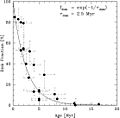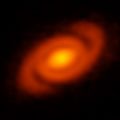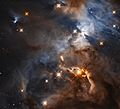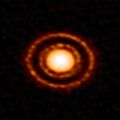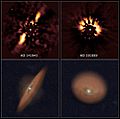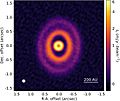Protoplanetary disk facts for kids
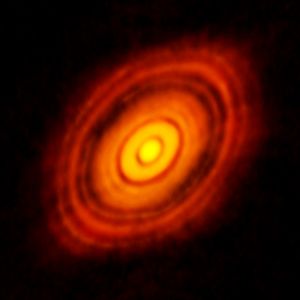
Imagine a giant, flat, spinning cloud of gas and dust around a brand-new star. That's a protoplanetary disk! These disks are like cosmic nurseries where planets are born.
They are made of thick gas and tiny dust particles. These disks spin around a young star that has just formed. Protoplanetary disks can be very big, stretching out to about 1,000 AU. An AU is the distance from the Earth to the Sun. Scientists have seen these disks around many young stars in our galaxy.
Protoplanetary disks are usually quite thin, like a flat pancake. They don't have as much material as the young star they surround.
Contents
How Planets Form
Protoplanetary disks are super important because they are where planets are made. Inside these spinning disks, tiny dust particles start to bump into each other. Over millions of years, these tiny bits stick together. They slowly grow into bigger and bigger clumps.
From Dust to Planets
First, dust grains combine to form pebbles. Then, these pebbles grow into rocks. Eventually, these rocks become planet-sized objects called protoplanets. These protoplanets keep gathering more material from the disk. This process is how planets like Earth, Mars, and Jupiter were formed in our own Solar System.
The Role of Gas
The gas in the disk also plays a big part. It helps to slow down the growing clumps of dust and rock. This slowing allows them to gently combine instead of crashing and breaking apart. The gas also helps to shape the orbits of the new planets as they form.
Observing Protoplanetary Disks
Scientists use powerful telescopes to study protoplanetary disks. These telescopes can see the faint light from the dust and gas. This helps us understand how stars and planets come to be.
Famous Observations
One of the most famous images of a protoplanetary disk is of HL Tauri. This image was taken by the Atacama Large Millimeter Array (ALMA) telescope. It showed clear gaps and rings in the disk. These gaps are thought to be caused by young planets clearing paths as they orbit the star.
What We Learn
By looking at these disks, scientists can learn about the early stages of planet formation. They can see how quickly planets might form. They can also learn about the types of planets that might exist around other stars. Some disks even show spiral arms, which could be signs of massive planets forming.
Images for kids
-
The protoplanetary disc AS 209 in the young Ophiuchus star-forming region.
-
Debris disks seen in HST images of young stars, HD 141943 and HD 191089.
-
The protoplanetary disk HH-30 in Taurus, showing a reddish stellar jet.
-
A proplyd (a type of protoplanetary disk) in the Orion Nebula.
See also
 In Spanish: Disco protoplanetario para niños
In Spanish: Disco protoplanetario para niños


